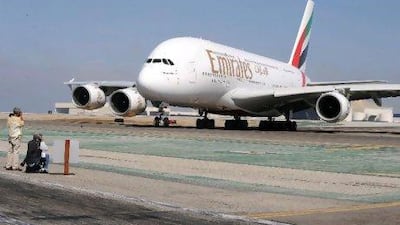One of the unusual things about Emirates Airline is that while it is one of the largest companies in the Middle East, it is also one of the least studied.
Few analysts follow the airline because it is government owned and unavailable to equity investors. So it was somewhat of a rarity when the Royal Bank of Scotland (RBS) published a report called "What would you do with 90 A380s?".
The title encapsulates much of the awe and incredulity surrounding the Dubai airline's success, the largest customer of the Airbus superjumbo and the world's largest airline based on international capacity.
While its order book of 90 A380s, which will hold nearly 45,000 seats, is unprecedented, the study comes to a surprising conclusion: Emirates' growth would not come at great expense to some of its rivals in Europe or Asia.
"It is possible to see a scenario in which Emirates takes delivery of all its ordered aircraft without gravely damaging European carriers," RBS said. Emirates orders, which total nearly 200 wide-bodied jets, could be absorbed by Emirates "growing in line with the market across most route areas," the study found. In addition, Emirates would find placing the 90 A380s due for delivery by 2020 on viable routes as "surprisingly easy" and "remarkably unchallenging".
The report looked at Emirates but also used it as a proxy for the other big Middle East carriers including Qatar Airways, Etihad Airways and Turkish Airlines, which all serve the long-haul, East to West transfer market.
These airlines have "significant growth plans, benefit from lower costs and operate with very supportive governments and high quality infrastructure," RBS said. It forecast these carriers to maximise their location to gain market share on several high-growth markets where they hold a competitive advantage.
They will gain significant market share for travel between North America and South Asia, between Eastern Europe and the Middle East, and between China to the Middle East and Africa. But Middle East airlines will struggle to gain market share where their hubs are not an advantage, such as travel between China and Europe.
"The Gulf carriers will not necessarily be the major destabilising force on the network carrier industry that some commentators fear," the analysis said.
Emirates' fleet of 151 wide-bodied jets is forecast to grow to 249 planes by 2020, after taking into account new deliveries and retirements. In 2015, Emirates should have 60 A380s in operation, which RBS forecasts will be used on 30 routes. These include cities that are outside the flying range of today's A380 such as Los Angeles, or cities that do not currently have the infrastructure to handle the aircraft today, like Nairobi.
Some cities will be served by high-density A380s with primarily economy-class seating, such as Mumbai, Delhi and Jeddah. The rest will be equipped with Emirates' current configuration of just under 500 seats. That includes seven points in western Europe, such as Munich and Madrid, six in North Asia, such as Shanghai and Osaka, and three points in Australia and New Zealand. There were some surprises in the forecast, such as an expectation that Emirates would fly three times a day into Moscow and Johannesburg.
By 2020, RBS forecasts Emirates to receive all of its 90 A380s, and will fly them to 44 destinations. The Emirates strategy will be to aggressively deploy the superjumbo onto long-haul sectors to the US and Latin America, and use them more broadly to China, the report said. New destinations could include Zurich, Istanbul, Chicago, Guangzhou and Mexico City.
Some European hubs are vulnerable to Emirates as it opens services to secondary cities on the continent, RBS concluded. Travellers in Germany's provincial cities, who used to fly to Frankfurt and then internationally on Lufthansa, may choose to fly more directly via Emirates.
Both Lufthansa and Air France are "notably disadvantaged" when linking travellers between secondary European cities and secondary points in Asia. Whereas Emirates would fly between Cochin and Birmingham via one stop in Dubai, it would take three stops on a European carrier. As a result, some countries such as Canada and Germany are blocking Emirates' growth, but RBS found the airline industry to be on a "clear path" towards liberalisation, and suggested European airlines would try to bring Middle East carriers into alliances.
There are also things that Emirates will not do, according to the RBS analysis. While it is a major operator between Australia and New Zealand, it is not expected to open services between Europe and the US.
And its location in the Gulf is not an advantage in serving traffic between China and Europe, which would result in a "circuitous" routing, RBS found.

